Page 1

Loading page ...
Pass your certification with confidence using GMAT Official Guide Data Insights Review 2023-2024, Focus Edition (2023), a resource packed with exam-style questions.

Loading page ...
This document has 168 pages. Sign in to access the full document!